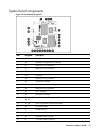
Diagnostic tools and setup utilities 112
Diagnostic tools and setup utilities
This chapter provides an overview of the Power-On Self-Test (POST), the POST error messages, and
BIOS, SAS and SATA setup utilities.
BIOS software
The server uses BIOS to boot up the system. BIOS software is a ROM-based firmware that allows
reliability, manageability, and connectivity for server platforms. This software contains a set of
programs permanently stored in an EEPROM chipset located on the system board. These programs
assist in managing, initializing, and testing the hardware devices installed on the computer.
BIOS software allows you to:
• Perform configuration from the BIOS Setup Utility
Using the Setup Utility, you can install, configure, and optimize the hardware devices on the
system board. In addition, you can set various features such as serial console redirection, PXE
boot, and much more.
• Initialize hardware at boot up using POST routines
During power-on or warm reset, the BIOS perform POST routines to test system components,
allocate resource for various hardware devices, and prepare the system to boot to various
operating systems.
BIOS Setup Utility
The HP server BIOS Setup Utility is used to configure five primary menu selections:
• Main
• Advanced
• Boot
• Security
• Exit
Accessing the BIOS Setup Utility
1. Turn on the monitor and server.
If the server is already turned on, save your data and exit from all open applications, and then
restart the server.
2. When the HP logo is displayed during POST, press F10 into BIOS Setup Utility. If you fail to
press F10 before POST is completed, you will need to restart the server.
3. The first page displayed is the Main menu showing the Setup Utility menu bar. Use the left (←)
and right (→) arrow keys to change the options for each setting. Use the up (↑) and down (↓)
arrow keys to move among the different settings in each menu.


















